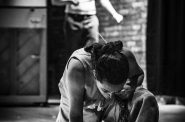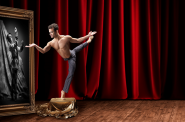Present Dance (and music too)
Present Music turns over the stage to dancers from the Milwaukee Ballet and UWM. Repeat performance Saturday (10/27).
I went to a fight the other night, and a hockey game broke out. — Rodney Dangerfield

Kevin Stalheim and the Present Music musicians in the pit, preparing for the performance. Photo: Angela Morgan
The Present Music ensemble stayed out of view in the pit Friday evening, as dancers from UWM and the Milwaukee Ballet filled the Zelazo Center stage. In theory, this Falling concert was a Present Music program. In practice, it was a dance concert.
Not that there’s anything wrong with that. One happy result was to get the Milwaukee Ballet’s dancers involved with other dance people in another venue. Another happy result: Dani Kuepper’s Slowly and Always.
Kuepper fully absorbed the moods and rhythmic impetus of Elena Kats-Chernin’s lyrical, Romantic brand of Minimalism in Summer, Fall and Spring from Seasons (2010, for strings and piano). MBC dancers Courtney Kramer, Janel Meindersee, Raven Nielsen, Mayara Pineiro, Etienne Diaz, Barry Molina and Isaac Sharratt found just the right sort of lyrical expression, with pliant limbs lightly but firmly held and a propulsive footstep of air. Their bodies fit the music, which is essentially pastoral even when the piano drives it ahead.
Kuepper – artistic director of Danceworks and member of the UWM dance faculty – understands musical and choreographic structure. Kats-Chernin fills her 15 or so minutes of music with three figures, one driving and rhythmic; another spiraling, melodic and expressive; and a sort of rustling, settling cadence. This material, in various guises, is the stuff of all three seasons. At least as music director Kevin Stalheim directed them Friday, they segued into one another. I couldn’t tell just where spring ended and summer began. (Note: The composer lives in Australia. The seasons are not like ours.)
Kuepper matches the driving music with a stylized, slowed-down dash, with arms bent at the elbows and pumping forward with knife-edged hands. The dancers constantly form ranks and run through floor patterns, in the way of ancient village dances. Sharratt introduces a spiraling, lyrical phrase as the poetic odd man out. As a season seems to conclude, everyone flits and whirls about, assumes tree-like poses and flutters to the floor like so many autumn leaves. As the dance progresses, the ensemble picks up Sharratt’s material and he theirs. The geometry becomes more fleeting and volatile. Dancers dash on and off, meet up in squadrons of three or four, and disperse. But still, the design is there; it’s a kaleidoscope, not chaos.
In a most charming touch at the very end, Sharratt spins off while holding the beautiful Mayara Pineiro aloft. Slowly and Always is by no means a narrative dance; even so the lonely, poetic guy gets the girl.
MBC’s Marc Petrocci and Courtney Kramer revived Simone Ferro’s 2007 Magnetic Field, to excerpts from Kevin Volans’ String Quartet No. 6, played by Zhan Shu, Margot Schwarz, Erin Pipal and Adrien Zitoun. As excerpted, the music is all gorgeous, sustained, sighing chords. Ferro, of the UWM dance faculty, filled in the time with long conversational phrases that play out like complex sentences. Petrocci and Kramer wound through their very close partnering, a good deal of it on the floor, with the sinuous physicality of two living ropes coiling and twining. Magnetic Field, though essentially abstract and blessedly free of face-acting, could be called Scenes from a Marriage. They reconcile, but in the middle separate and dash about with urgent force but no destination. Ferro gave them a telling gesture of separation: Their joined hands snap apart like a breaking rubber band under tension. Through all of this, video of the dance, processed and delayed with great sensitivity by Iain Court and Jessica Peck, shadows the live dancers in a most intriguing way.
Ferro fared far worse in the new Dis-Equilibrium for MBC’s Justin Bohan, Mengjun Chen, Susan Gartell, Valerie Harmon and Erik Johnson, with Rachel Malehorn in a featured role. The music: Christopher Cerrone’s tense, dissonant The Night Mare and Jennifer Higdon’s vibrant, rhythmic Zaka. Kellie Bronikowski’s film of aerial views from around town, mostly of UWM and the Blatz complex, played throughout in the background, leaving the dancers mostly in half-light. Focusing on the dancers was neither easy nor very rewarding. If the point was to show maximum effort to achieve crabbed movement not congenial to the human body, it made the point, but that’s not a party I want to attend. The movement appeared atomized and arbitrary, or at least with no structure I could grasp, and Ferro ignored the momentum of Higdon’s music. It screams velocity and thrust, but Ferro stuck with struggle.

UWM Dance students perform Petr Zahradnicek’s “Fall to Rise” during the collaborative concert Fall(ing) with Present Music and The Milwaukee Ballet. Photo: Angela Morgan
MBC’s Petr Zahradnícek set Fall to Rise on 11 female UWM student dancers (fetchingly costumed in Marion Clendenen-Acosta’s trim, swingy black dresses) to Nico Muhly’s episodic Honest Music and the atmospheric, catacomb-like Quiet Music. He took the concert’s Falling theme seriously; the women, in tight formation, collapsed abruptly and almost immediately. The fragmented nature of this music – which I like a lot, by the way – doesn’t suggest dance. For the most part Zahradnícek found little to do with it beyond having the women dash to another part of the stage and collapse again. The best bit came when just three women became the Three Graces during a more sustained agitated passage in Quiet Music. There, Zahradnícek had more to work with. Otherwise, Fall to Rise looked like a choreography class project: “Today, make phrases that involve falling and getting up…”
More by chance than plan, MBC’s Tim O’Donnell ended up with Kats-Chernin’s Winter, left over from Dani Kuepper’s larger work. O’Donnell made of it the cleverest fractured-fairy-tale, nine-minute gloss on Swan Lake, even though the music has no whiff of Tchaikovsky. In identical makeup and in stage light, Annia Hidalgo and Mayara Pineiro could be twins; I couldn’t tell which was Odette and which was Odile. But give me a break — neither can Siegfried, Mengjun Chen in this case.
Just the barest wisp of narrative runs through this Cubist breakdown of Swan Lake steps and gestures. The dancers, all fabulous, let bits of Swan mime and step flicker through the giddiest rococo arms, all delivered with deadpan seriousness. I liked the gray costumes, too, elevated rehearsal clothes, nifty brief shorts and casual gray tops, with toe shoes for the women. O’Donnell’s Bird-Prince-Bird stands nicely on its own, but it feels like a study for a larger work. I hope so.
Like this story? Click on the red byline at the top for a full slate of TCD articles by Tom Strini.
Dance
-
New Riverwest Company, Production Impresses
 Feb 10th, 2020 by Brendan Fox
Feb 10th, 2020 by Brendan Fox
-
Milwaukee Ballet Show Remakes History
 Feb 10th, 2020 by Catherine Jozwik
Feb 10th, 2020 by Catherine Jozwik
-
Ballet Does Free Production of ‘Nutcracker’
 Dec 20th, 2019 by Richard Davis
Dec 20th, 2019 by Richard Davis

















They are NEVER called toe shoes. EVER. Pointe shoes. Just shows Tom’s lack of knowledge in the field that he is critiquing.
Well, Jane, maybe not always…
http://www.nycballet.com/Support/Special-Projects/Toe-Shoe-Fund.aspx